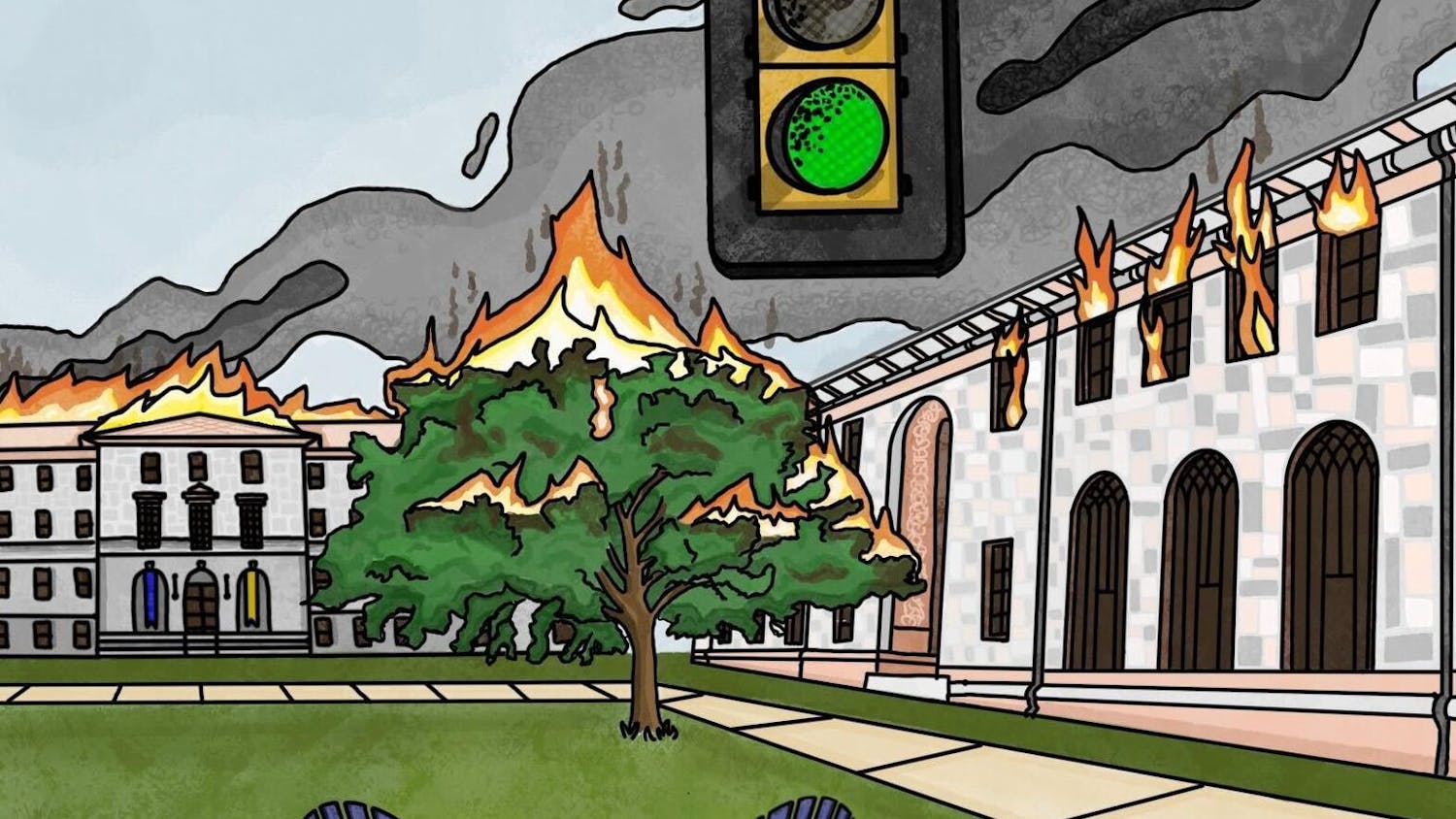
A has-been classics teacher who can’t stand his students. A grieving cafeteria manager with an attitude and a penchant for alcohol. An upstart teen without regard for authority. Two weeks cooped up in an all-boy’s boarding school. “Dead Poets Society” (1989) meets “Lady Bird” (2017) meets “Ferris Bueller’s Day Off” (1986) in Alexander Payne’s newest production, “The Holdovers.”
Paul Hunham (Paul Giamatti) is the Scrooge of Barton Academy, delighting in giving out failing grades and assigning homework over break. His adherence to history doesn’t just apply to his ancient civilization curriculum: He can’t seem to let go of tradition, the past and what he could have been.
One of said students, Angus Tully (Dominic Sessa), is scathingly sarcastic and on the verge of being sent to military school. Despite doing well in Paul’s class, the two grate against one another whenever they interact. Angus refuses to keep his mouth shut and can’t stand Paul’s obsession with obedience and rule-following. Paul has no tolerance for neither mistakes nor mischief of any kind, especially not from the privileged pupils he teaches. This combination of traits earns Angus’ entire class extra assignments and earns Paul the cruel nickname “Walleye” amongst the boys, a jab that refers to the teacher’s glass eye. They have just about nothing in common.
That is until Paul is forced to remain at the boarding school over break to watch the remaining students because the headmaster is angry with him for failing the son of wealthy donors and partly because he has no one else to be with on the holidays. A similar change of fate falls on Angus, who receives word that his mother is taking a belated honeymoon with his new stepfather. This last-minute change traps them together at the boarding school along with four other students and Mary Lamb (Da’Vine Joy Randolph), who stays behind to cook while fighting to keep the grief of her son’s death.
After a few days of laughably miserable conditions pass, a near-Christmas miracle takes the other four students away for the remainder of the holiday, leaving Angus alone with Paul and Mary. As Christmas approaches, a fateful dash across the off-limits gym floor and over a hurdle dislocates Angus’ shoulder from its socket — and the group from the confines of campus.
This wound breaks some of the bitterness between the characters, and from that point on the heart of the film unfolds. Even as the characters leave the school to travel into town and to Boston, they still feel stuck, or rather, bound together. Despite their shared animosity, Paul and Angus manage to compose themselves enough to help Mary through her grief and actually get to know one another. Mary keeps them both in check and never takes one side over another. It’s a strange dynamic that somehow works perfectly.
It is clear from the second the first retro studio title appears that “The Holdovers” isn’t your average Christmas flick. The dry humor, ’70s hairstyles and complex convictions of Payne’s characters bring the bite and bliss of winter to the screen in a refreshing, yet nostalgic, way. The movie looks as though it was plucked right out of ’70s theaters and rebooted in modern ones, and its rich holiday aesthetic makes you want to curl up with a cup of hot cocoa.
The blissfully-bleak winter landscape, a result of special effects supervisor Adam Bellaoconvincing Boston-area schools and businesses to save up snow, saturates the screen with Christmas quietude. Melancholic choral music and the soft sounds of Damien Jurado’s “Silver Joy” (2014) accentuate both the isolation of the abandoned school and the warmth of the relationship between the three campus hermits. The contrast of warm and cold mimics the balance between humor and heartfelt emotion in “The Holdovers.”
And though the 35-millimeter film visuals might send the audience into the past, the three central characters’ dynamic feels relatable in the present. Likewise, Payne’s artful camerawork gives the feature a modern flavor. In so doing, the discussions of grief and loneliness are even more heart-tugging: Mary grieving her son, Angus grieving his fragmented family, Paul grieving a life not fully lived. As the story progresses, it turns out they have more in common than any one of them thought.
Depending on who the viewer focuses on, the three characters can take away any number of messages about moving on. Luckily, there’s no need to choose: each character is given what Payne describes as “plenty of ink.” Even the supporting cast is thoroughly developed, from Mary’s love interest to the ragtag troop of boys stuck with Angus at the start of break. It’s a testament to both the writing and the acting that not one scene feels flat or inauthentic. In the scenes when Paul, Mary and Angus are together, usually in the school’s all-but-empty dining hall, the group’s chemistry is undeniable. Their dynamic helps make light of their bleak situation and indicates that you can always find comfort in the holidays, especially when you take the time to get to know someone.
“There is nothing new in human experience,” Paul tells Angus after dragging him to the Museum of Fine Arts, Boston, pointing out crude images on the ancient pottery. Despite the humor in the pornographic image on the ceramic Paul references, he earnestly explains that even ancient people were not all that different from us. If we try to understand them, maybe we can understand ourselves a little better.
“The Holdovers” makes you feel nostalgic for a time you have never lived in, and the characters make you feel known by people you have never met. Despite its lengthy plot, the movie maintains its sense of heart and humor up to the end. Ultimately, the viewing experience is like an old wool sweater: scratchy, but warm and comforting in all the right ways, begging to be put on time and time again every holiday season to come.







